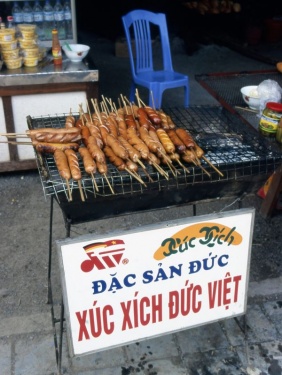Hoc to, hoc Noi (Man learns to eat before he speaks.) This is a Vietnamese proverb. Vietnamese food means mainly rice and noodles in many variations. Vegetables and fragrant herbs are part of every meal. As anywhere else in Asia, people also eat a lot of tofu or soybean curd. In a country with over 3,000 miles of coastline, fish and seafood are an integral part of the traditional cuisine. Poultry, beef and pork are also available on every market. For about ten years, the Vietnamese cuisine has been enriched by something else – the Thuringian bratwurst. It is produced in a factory, belonging to the company-Việt Đức CO., LTD, about 30 kilometers southeast of Hanoi. The two managing directors, Dr. May Tân Huy from Hanoi and Michael Campioni from Erfurt, had the idea to offer the Thueringer Bratwurst (as it is called in German) to the many Vietnamese who once lived in the GDR and now miss the grilled sausage. This has been a story of success. Meanwhile, the sausage is produced according to European standards of hygiene. The 100 employees – children from rice farmers from surrounding villages – learnt by German butchers how to cut pork. More than 100,000 sausages are now sold each month, not only in Hanoi alone, but also in other major cities. The logo and the green packaging are so well known in the country that there are even some imitators. In the company’s range there can be found now also cooked ham, ham sausage and German mustard. In compliance with the cold chain, hotels, schools, beer gardens, kiosks and supermarkets are supplied with the sausage. As if it were spring rolls, the popular sausages are served with chopsticks. And instead of the obligatory fish sauce, mustard comes with it. In my opinion, that doesn’t taste quite as good as real sausages from Thuringia in Germany, but they’re still tasty. Best regards Cathrin




